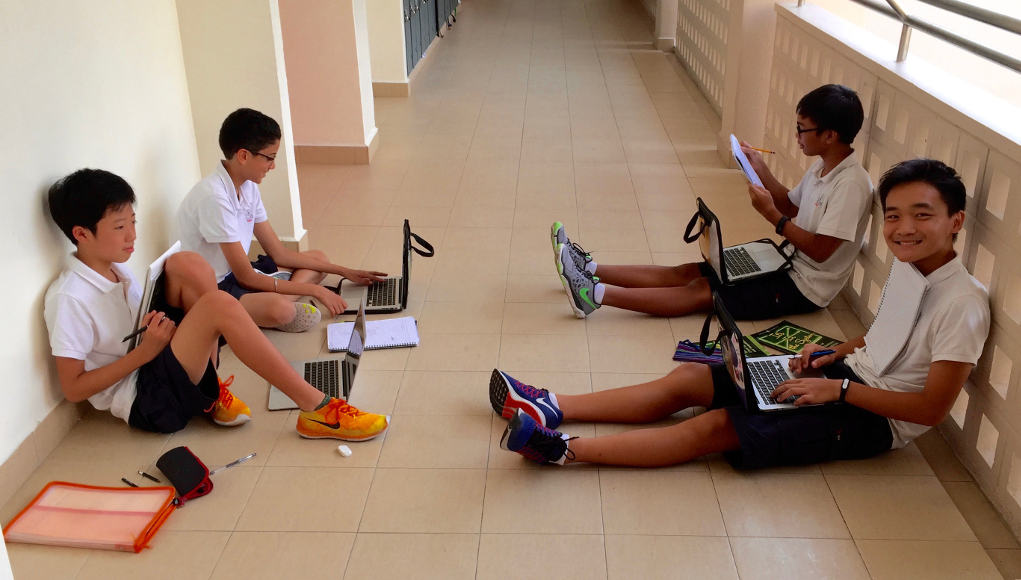18 Tips for Making Blended Learning More Student-Centered

The historic shift from print to digital offers transformational opportunity in education, but efforts to “integrate technology” into our schools can leave untouched many historical challenges—inconsistent engagement, low levels of motivation and few chances to build agency and collaboration skills.
Schools seeking to boost motivation, engagement, agency and collaboration are adding student-centered learning strategies to their blended learning plan. Following are 18 tips from leading schools and providers.
Work Around The Edges
Flipping a traditional school to more student-centered learning experiences is challenging. As a large traditional school, the Singapore American School (SAS) faculty decided to begin their transformation by working around the edges.
Examples of launching student-centered change by starting on the edges include:
1. Genius Hour: A weekly period where students guide their own inquiry.
2. Makerspace: Dedicated spaces with materials and equipment available for student-directed production, and available during scheduled and free time (see Lindsey Own’s maker series).
 3. Applied STEM: Freshman in a dual language STEM class in El Paso (left) speak English one week, Spanish the next while designing bridges and race cars in WhiteBoxLearning, a CAD program that supports design with short physics lessons. Students can pressure test their bridge and drag race their cars before building models using jigsaws and 3D printers.
3. Applied STEM: Freshman in a dual language STEM class in El Paso (left) speak English one week, Spanish the next while designing bridges and race cars in WhiteBoxLearning, a CAD program that supports design with short physics lessons. Students can pressure test their bridge and drag race their cars before building models using jigsaws and 3D printers.
4. Upper division courses: Replace some AP classes with student-driven research projects. At Singapore American School these are called Catalyst projects (also see Chavez Schools).
5. Add microschools: Kettle Moraine School District opened a small elementary and three small high schools (two teachers and 40 students) to introduce blended, interdisciplinary, and competency-based learning.
Voice & Choice
Within core academic offerings, periodic efforts can be made to give students more options about what they study and what they produce.
6. Values-based culture: DSST starts each day with a morning meeting to celebrate and reinforce shared values. Students meet with their advisory daily and hold a goal setting meeting weekly. Beacon Schools, another Denver network, provides feedback on character strengths every day.
7. Add projects: Giving students some optionality about the focus of a project and the final product. At Katherine Smith Elementary in San Jose, whole classes are often involved in developing driving questions, project teams then further refine their investigation with specific goals and deliverables. Well-developed project plans and rubric-based assessment combine these interest-based explorations with standards-based outcomes.
8. Add challenges: Digital Promise advocates for using attacking real community challenges (like #GlobalGoals) to frame project-based learning.
9. Combine personalized and project-based learning: A growing number of districts and networks are combining blended learning and project-based learning in thoughtful ways. This addresses historical challenges of weak preparation for challenging PBL (free rider and swiss cheese).
10. Practice design thinking: At Design Tech High School in San Mateo and the Denver School of Innovation and Sustainable Development, design thinking strategies are used across the curriculum to help students practice empathy, imagine better futures, and prototype solutions. At Olin College, students use design thinking in every class starting day one.
Design thinking strategies can be introduced in an afterschool program (see our feature on an after school student marketing agency in Boise), during an intersession or in preparation for service learning.
Extensions
11. Portfolios: Curating a portfolio of quality work products helps students chart their own progress and take ownership of their learning. At Mukilteo Elementary (north of Seattle), the year culminates with a family picnic and portfolio review.

12. Project mentors: Educurious provides project-based curriculum supported by industry mentors.
13. Work-based learning: Helping students select and shape community-based learning including work, service or civic activities can be a great way to develop student agency and boost career readiness. Every Friday, students at Quest Early College High School (north of Houston) spend learning in the community.
Path & Pace
14. Adaptive learning: By adding 90 minutes a week of adaptive learning (e.g., i-Ready or Dreambox) to K-8 blends provides diagnostic data and personalized learning to accelerate progress.
Columbus Mississippi schools use an adaptive learning platform to take advantage of adaptive learning across the curriculum (listen to a podcast with superintendent Dr. Philip Hickman).
15. Place-based education: Take advantage of geography to create authentic, meaningful and engaging personalized learning for students. According to a new report, place-based education is an immersive learning experience that places students in local heritage, cultures, landscapes, opportunities and experiences.

16. Travel-based learning: Democracy Prep Public Schools founder Seth Andrew spoke with us about how their students visit five continents before graduation in this podcast. University Academy leadership shares the same belief in the importance of students participating in international travel, and Superintendent Tony Kline and Assistant Superintendent Rebecca Gudde share more in this podcast.
17. Competency-based education: Competency-based systems ask students to show what they know through frequent performance tasks. Students progress based on demonstrated mastery. They receive more support when and where it is required.
18. Interest-based learning: All of these strategies have the benefit of boosting the quotient of interest-based learning where students are in the driver’s seat. Artful teachers can guide student investigations and co-construct projects packed with literacy and problem-solving.
For more, see:







0 Comments
Leave a Comment
Your email address will not be published. All fields are required.